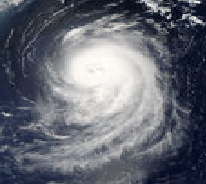Hurricane Sandra
| Category 5 hurricane | |
|---|---|
| Formed | April 18, 2139[1] |
| Dissipated | April 23, 2139[1] |
| Highest winds | 150 knots (280 km/h, 175 mph) (1-minute sustained winds) |
| Lowest pressure | 900 hPa |
| Damages | L£1.5 billion |
| Fatalities | 36 |
| Areas affected | Spero Noei, Laudo Deo |
| Part of the 2139 Southeastern Heartland hurricane season | |
Hurricane Sandra was a rare Category 5 hurricane and the deadliest storm of 2139 anywhere in The Heartland. Sandra was the fourth named system of 2139 (when naming of tropical depressions was still common, Tropical Depression Pete was named earlier in the season), and the second named storm within the then-Liverpool England Meterological Service Cyclone Prediction Centre's new expanded area of responsibility (before the new Hurricane Prediction Centre took full control of naming and advising on storms in 2140).
Sandra made landfall as a Category 1 hurricane on Laudo Deo, causing at least 36 deaths, and at least L£1.5 billion in damage (preliminary estimates).
Storm history
Hurricane Sandra began life as Tropical Depression Two (despite the designation, there had been three other earlier depressions in the season — Pete, Queta and Ralph) south of The South Packerlands and east of Laudo Deo on the morning of April 18, 2139[1]. Within the first two advisories, Tropical Depresison Four had strengthened into Tropical Storm Sandra, and tropical storm watches had been issued for the FN Fortress of Spero Noei, which was the southeasternmost land mass within the area of responsibility then. Sandra then started speeding up while it moved eastwards.
It reached hurricane strength in Advisory 3 (9 p.m. local time the same day it formed), becoming the first ever hurricane in the new AOR. It strengthened quickly overnight, reaching Category 3 strength 12 hours later. However, due to legal limitations, the potentially deadly storm, which had already claimed one life while crossing the FN Sea Fortress (which the LECPC did not designate as a landfall[2]), was not allowed to be advised on once it had left the AOR, which it did two and a half hours after Advisory 4. The effect of land was quite significant, as it turned Sandra towards the southwest, and towards the edge of the AOR.
By the time it had left the AOR, it had become a Category 4 hurricane, packing sustained winds of 115 knots (215 km/h or 135 mph). In place of advisories, the MSCPC issued products it called "discussions" on Sandra while the storm was outside the MSCPC's jurisdiction. The first-ever discussion released was the first advisory to warn that Sandra had the potential to become a Category 5 hurricane, noting that "the prediction models all estimate for Sandra to possibly reach an extremely rare Category 5 strength."[3]
Notes and References
1Liverpool England time.
2Hurricane Sandra Bulletin Advisory 004, Liverpool England Met Service Cyclone Prediction Centre.
3Hurricane Sandra Discussion Advisory 001, Liverpool England Met Service Cyclone Prediction Centre.

